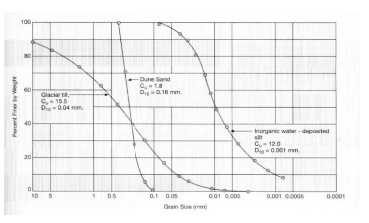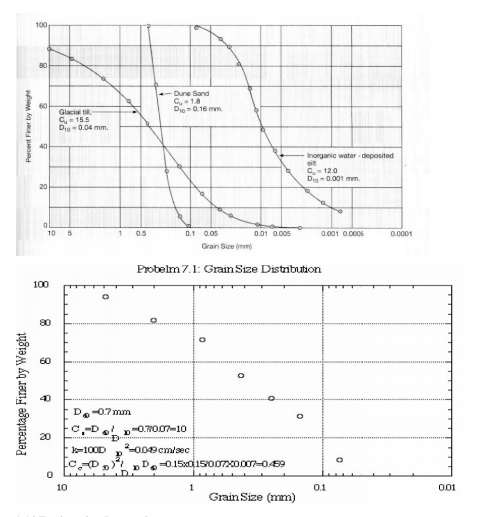Chapter: Civil : Soil Mechanics : Soil Classification And Compaction
Soil Mechanics: Index properties

Soil Mechanics: Index properties
Index properties
1 Particle Size Distri bution
First of all, let's discuss the sieve that is the
essential tool to study particle size distribution.
U.S.
Standard Sieve Sizes
Sieve Sieve opening (mm)
4 4.75
10 2.00
20 0.850
40 0.425
60 0.250
100 0.150
200 0.074
2 Gradation:
Gradation is a measure of the
distribution of a particular soil sample. Larger gradation means a wider
particle size distribution. Well graded Ù poorly sorted (e.g., glacial till)
Poorly graded Ù well sorted (e.g., beach sand)
The range of grain size
distribution is enormous for natural soils. E.g., boulder can be ~1 m in
diameter, and the colloidal mineral can be as small as 0.00001 mm = 0.01
micron. It has a tremendous range of 8 orders of magnitude.
Example: If you
have a soil sample with a weight of 150 g, after thorough sieving you get the
following result.
sieve size(mm) W(g) % accum% 100accum%
4 4.750 30.0 20 20 80
20 0.850 40.0 26.7 46.7 53.3
60 0.250 50.0 33.3 79 21
100 0.150 20.0 13.3 92 8
200 0.074 10.0 6.67 98 2

The last
column shows the percentage of material finer than that particular sieve size
by weight.
There are a number of way s to
characterize the particle size distribution of a particular soil sample.D10:
D10 represents a grain diameter
for which 10% of the sample will be finer than it. Using another word, 10% of
the sample by weight is smaller than diameter D10. It is also called the
effective size and can b e used to estimate the permeability.
Hazen's approximation
(a n empirical relation between hydraulic conductivity with grain
size)
k (cm/sec) = 100D10D 10
Where D10 is in centimeters.
It is empirical because it is not consistent in dimension
(cm/sec vs cm2).
Uniformity coefficient Cu :
Cu = D60/D10
Where D60 is the diameter for which 60% of the sample is finer
than D6 0.
The ratio of two characteri stic
sizes is the uniformity coefficient Cu. A pparently, larger Cu means the size
distribution is wider and vice versa. Cu = 1 means unif orm, all grains are in
the same size, such as the case of dune sands. On the other extreme is the
glacial till, for which its Cu can reach 30.
from Cu = D60/D10 , then D60 = CuD10
Coefficient of Curvature Cc
Another shape parameter, as the
second moment of grain size distribution curve, is called the coefficient of
curvature, an d defined as
Cc = (D30
D30)/ (D10 D 60)
A soil is
thought to be well graded if the coefficient of curvature Cc between 1 and
3,with Cu greater than 4 for gravels and 6 for sands.

Related Topics